LANDSCAPE DESIGN WITH PLANTS
LA701 | TRANG VU






I chose Nelson Mandela Garden as my study location and observed it every month to understand every nuance and change that occurred there.
Located just by Millenium Square, Mandela Gardens is a peaceful retreat in the busy city centre. The garden commemorates the life and legacy of Nelson Mandela. was reimagined by city Architect John Thorpe. The new gardens included a water feature and stone seating alongside a bronze sculpture by Kenneth Armitage (b.1916 Leeds) entitled ‘Both Arms’, at 16 feet high the bronze cast sculpture is designed to convey a friendly, welcoming atmosphere.
Detailing of hard landscape materials, which includes yorkstone and granites, combine to form pathways, steps, combine planting communities, flower beds are planted with plants native to Britain and South Africa while the water sculpture is said to be symbolic of the bars of Nelson Mandela’s prison cell. - all of which are further complemented a Hidden Nature, Hidden History corner of busy Leeds
 Figure 1: A photo of Nelson Mandela Garden
Figure 1: A photo of Nelson Mandela Garden
The garden is contrasted the exotic bright colours of South Africa with the traditional formal Bristish garden shades of green and white. The plants reflect the warmth of South Africa with the more temperate English climate.
Far left Arum lily
centre- King protea
Above- Clivia miniata



Far right chipped box hedges
Centre-White iris
Below - Marsh marigold





This sketch to show the garden actually faces southwest and the intersect, making the site quite a sunny spot however seating still sheltered by a number of trees in the border and the hedge.It is noted on this drawing is the colourful herbaceous and shrups popping up around 3 olive Trees.
Figure 3: A sketch of Nelson Mandela Garden plan, by author Figure 2: A sketch of Nelson Mandela Garden plan, by authorIn April, It's the time of leaf growth. It' s the season increased sunlight, and the ground softens and the soil retains water
As the tree begins to take in sunlight, leaves and buds grow. trees start to take down their barriers and get ready for the growing season. The plants begin to show symptoms of little buds sprouting from the branches

In May, the leaves proliferate and the flowers open, attracting pollinators. Luzula nivea blooms tiny white flowers attracting bees, while the Olive tree leaves more greenery. grass grows taller day by day and fill soil surface .

The sun is at its peak in June, midsummer, and the plant’s spread is at its greatest There are more colors with the blooming of Yucca and change color of feather reed grass from green to brown.
There is a lot of sunlight making the plants lush, and some late-blooming flowers have also appeared, making the garden most colorful at this time also the time when the garden has the most vitality

In the late summer of August, the growing leaves of plants and trees cover the entire garden. The significance of each plant is complex Flowers die at this time of year, only to bloom again the following year.
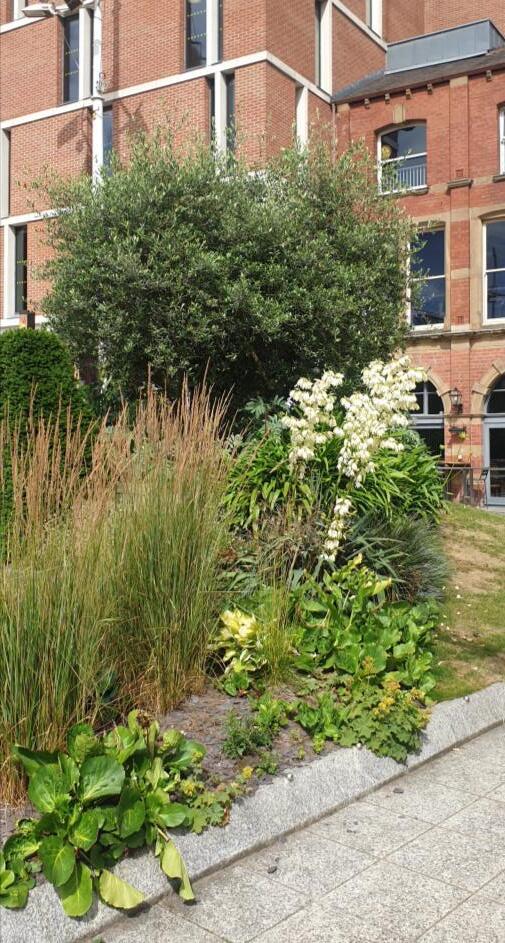


My first month of observation is in mid-spring when the plants are trimmed to increase their presence for the upcoming summer. This was the best time to analyze the development of each plant in the garden. at this time. New buds open and young leaves grow, the trees are still small with light green color creating a joyful feeling of spring. Large, neatly trimmed trees like English yew and new buds opening on olive trees. The bushes are still neat and have not spread widely
Taxus Baccata English yew Olive trees African Lily Calamagrostic Hemerocallis fulva Orange daylily Hemerocallis fulva Orange daylily Figure 5: A wide perspective in the month of April Olive trees
New fresh, skinny leaves
English Yew newly trimmed
Canopy trees
Behind sitting spot for shading in summer


New grass growth from the base
New fresh leaves,



The olive tree, Olea europaea, is an slow-growing evergreen of Mediterranean origin. It forms a rounded head of small, silver-grey leaves and is tolerant of hot, dry conditions. Tiny creamy-white flowers appear in summer, followed by small, round green olives that ripen to black.In the UK olive trees require a warm, sheltered spot to thrive.
Is a native British evergreen tree. Young plants are bushy and make a fine hedge or topiary specimen, but, if left unclipped they eventually grow into a large conifer tree. Yew withstands quite hard clipping and, if overgrown, can be rejuvenated by cutting back to the stumpssmall to. Medium-sized 10-20m

 Olea europaea Olive tree
Taxus Baccata English yew hedge Olea europaea Olive tree
Figure A sketch of plants, by author
Figure A sketch of plants, by author
Olea europaea Olive tree
Taxus Baccata English yew hedge Olea europaea Olive tree
Figure A sketch of plants, by author
Figure A sketch of plants, by author

As it was late spring, I noticed some development of new buds, leaves, flowers, and color in the second month. There were some trees and plants that grew quickly, as shown in the figures. At this time, there are some plants that have white flowers such as lazula nivea, yucca filamentosa and the color change of Calamagrostic is easily noticeable in the garden in May. Other shrups have also grown taller
Geranium Campanula poscharskyana Luzula nivea Calamagrostic Hemerocallis fulva Orange daylily


Hemerocallis fulva
Clusters of new buds waiting to bloom.
Campanula poscharskyana -sebrian bell flower
- Orange day- Lily Clusters of Purple flowers attracting pollinators.
Small pure white flowers begin to grow from the green leaves and attract pollinators.
Calamagrostis
The reeds grow taller and the tops begin to turn bronze
Luzula niveais an upright grass with good year-round interest, bearing feathery plumes in summer and bleached stems catching frost through winter. Its architectural shape lends it to use as a striking focal point in gardens. It can form clumps of stems up to 2m high if grown in moist soil.


it's a spreading, clump-forming evergreen perennial. It has rich, green leaves, which contrast with pure white summer flowers held on tall stems. A member of the rush (Juncaceae) family, Luzula nivea is commonly used for ground-cover and edging paths, particularly in shade.

 Calamagrostis Feather reed grass Luzula nivea Snowy woodrush
Figure A sketch of plants, by author
Figure A sketch of plants, by author
Calamagrostis Feather reed grass Luzula nivea Snowy woodrush
Figure A sketch of plants, by author
Figure A sketch of plants, by author

As summer approaches, the leaves turn a vibrant green, and flowers bloom, showcasing the hues unique to their species. For the purpose of luring polli - nators, some plants, like African Lyly, or Lazula release an odor. At this time, the garden begins to have a special change in color and fragrance
The garden in June is filled with the orange color of Orange daylily. Yucca filamentosa flowers bloom and radiate fragrance.
Luzula nivea Yucca filamentosa Calamagrostic African Lily African Lily Hemerocallis fulva (Orange daylily) Figure 10: A wide perspective in the month of June



Repis paludosa
The marsh hawk's-beard Yellow flowers on the grass appear
At this stage the reed havefully developed highlight a bronze zone
At this stage the reed havefully developed highlight a bronze zone Calamagrostic
White flowers fully bloom and stand out Yucca filamentosa Calamagrostic
Hemerocallis fulva Orange daylily
Fully blooming
The vibrant red and orange giving a sense of place.
Yucca filamentosa is a perennial, broadleaf evergreen, clumping shrub. It is native to the Southeastern United States. It grows 3 to 8 feet tall and 3 to 5 feet wide. Grow this yucca in full sun or partial shade.


Hemerocallis fulva is a vigorous, clump-forming perennial to 1m tall with strap-shaped leaves, the outer ones arching outwards and the inner leaves upright. Large numbers of trumpet-shaped, the flowering stems in summer

 Hemerocallis fulva Orange daylily
Yucca filamentosa Hemerocallis fulva Orange daylily
Figure A sketch of plants, by author
Figure A sketch of plants, by author
Hemerocallis fulva Orange daylily
Yucca filamentosa Hemerocallis fulva Orange daylily
Figure A sketch of plants, by author
Figure A sketch of plants, by author

In the middle of the summer, when the flowers are in full bloom and the shrubs and trees are tall.all The trees become luxuriant in July. While some white flowers have gradually faded, there are many flowers in the garden that are in full bloom at this time, giving the garden a symphony of color, especially the flowers that carry the colors of the garden. African, colorful and eye-catching. Mainly the purple color of the African Lily flower combined with red hot poker and New Zealand Flax leaves
Phormium (new zealand flax) Calamagrostic Agapanthus africanus African Lily Hemerocallis fulva (Orange daylily) Agapanthus africanus African Lily Figure 12: A wide perspective in the month of July


At this time, the tree has the darkest yellow-orange color to create the atmosphere of a garden in African
The late summer purple Ajuga reptans and African Lily supporting the orange Red hot poker and the brown Calamagrostis create an exotic colour picture
The blooming of red hot poker has added hot colors to the garden, bringing vitality and summer atmosphere.
By this time, the garden was filled with purple African liLy. Purple and white flowers bloom in spherical shape, growing among other flowers and plants and planting borders under the shade of olive trees, creating a unique atmosphere for the garden in July

Kniphofia is a genus of perennial flowering plants in the family Asphodelaceae, Species are native to Africa. Herbaceous species and hybrids have narrow, grasslike leaves 10–100 cm long. All plants produce spikes of upright, brightly coloured flowers well above the foliage, in shades of red, orange and yellow, often bicoloured. The flowers produce copious nectar while blooming and are attractive to bees and sunbirds.


Agapanthus africanus (African Lily) is an evergreen perennial with showy rounded clusters of funnelshaped blue flowers in early to mid-summer. Easy to grow. pest and disease free. this African Lily is quite vigorous and grows up to 2-3 ft. tall (60-90 cm). Thrives in full sun in fertile, moist, and well-drained soil. In a hot climate area. Agapanthus will do better in partial shade. Most varieties will lean toward the sun, which makes a south-facing border the best location.



The plants began to show signs of dryness in my final month of observation, late summer when the scorching sun was at its strongest.
In general, we can see that the leaves of trees and shrups have grown beyond control and become luxuriant, completely different from the image of trimmed plants in April and May. Like Melianthus Major has grown beyond the big trees, the New Zealand flax tree has grown to the point of overflowing the steps.
At this point, flowers also began to die. Some colourful flowers such as the orange daylily have completely withered, leaving only the yellow colour of the leaves. The most typical flower of the garden, the African Lily, has gradually dried up. Yellow leaves have begun to appear on the broad-leaved trees that create shade in the borders, ferns and some other shrubs have also begun to have yellow spots.

Red hot poker has gradually dried up

the orange daylily have completely withered

Yellow leaves have begun to appear on the broadleaved trees
Agapanthus africanus African Lily Hemerocallis fulva (Orange daylily) Polypodiopsida Fern Melianthus Major



Agapanthus africanus African lily
Polypodiopsida (Fern )
overgrown and has begun to wilt
Hemerocallis fulva orange daylily have completely withered
Fascicularia has gradually dried up
the flowering takes place, the inner leaves turn bright crimsonred around the central cup when at the centre. a stunning effect happen when there is the intense sunlight of heatwaves in late summer.
Melianthus Major overgrown beyond the big tree
Olea europaea
Olive tree
Produce fruits
 AUGUST’S COLOUR PALLETT
Figure 15: site photo of Mandela garden in the month of July
AUGUST’S COLOUR PALLETT
Figure 15: site photo of Mandela garden in the month of July

This unusual plant is a Chilean bromeliad which requires special care to get it to perform in UK gardens and conservatories. It can and does thrive outside if you get its location right although it will not tolerate any frost. The inner leaves turn bright crimson-red around the central cup when flowering takes place at the centre. All in all a stunning effect over many weeks in summer. F. bicolor hates wet and damp which can so easily cause its crown and leaves to rot off in winter. Poor soil is fine providing the plant is grown in full sun. Without sun you will not see the central leaves turn crimson and the flowers appear. It has Blue flower in Aug, Sep, Oct, Foliage evergreen and grow in clumpforming in a sheltered position, height 50cm
The most sumptuous foliage plant for the hot, dry garden. Comes from S. Africa, so not reliably hardy in the coldest counties. It has survived many years in the gardens here in East Anglia, in well-drained soil, sprouting from its woody base after severe winters. A mulch of light material protects the underground shoots. Large grey-green leaves, deeply cut and tooth-edged are proudly presented on thick branching stems. If over-wintered deep maroon curved flower spikes should appear. Foliage evergreen and grow in clump-forming in a sheltered position, height 2 cm


 Melianthus major Fascicularia
Figure A sketch of plants, by author
Figure A sketch of plants, by author
Melianthus major Fascicularia
Figure A sketch of plants, by author
Figure A sketch of plants, by author
It can be seen that the garden has thougfully selected plant species that match the idea and inspiration of a Nelson Mandela memorial garden. The colorful colors and forms of the plants also give the feeling of an African oasis in the middle of a busy city intersection.
Best of all, looking through the spring and summer months shows that everything doesn't bloom at the same time, but there are plants that bloom specifically in each month. This makes the garden always attractive.
 Figure A sketch of plants, by author
Figure A sketch of plants, by author

Nigel Dunnett one of the world’s leading voices on innovative approaches to planting design. He is a plantsman, designer and pioneer of the new ecological approach to planting gardens and public spaces.

His work revolves around the integration of ecology and horticulture to achieve low-input, high-impact landscapes that are dynamic, diverse, and tuned to nature.
Naturalistic plant design
 Nigel Dumett
Nigel Dumett
Nigel Dunnett is Professor of Planting Design and Urban Horticulture in the Department of Landscape Architecture at the University of Sheffield, and is one of the world’s leading voices on innovative approaches to planting design.
A primary objective of Nigel’s work has been to move the consideration of planting design and landscape horticulture from a largely cosmetic, decorative and functional role, to one that is also central to the discussion of how to address the major problems of climate change and a sustainable future.
Nigel’s focus is at both the large scale and at the smaller scale: gardens, urban parks, and in highdensity built development, applying ecological concepts within horticulture, landscape architecture and garden design. Specifically, this work has included bold and dramatic naturalistic planting design; ‘modern meadows’; Water-Sensitive Urban Design and SuDS applications; biodiversity-enhancing design; and green roofs and roof gardens.
Key work by Nigel are the Olympic meadow, Sheffield’s Grey to Green scheme, The Barbican and various gardens at the Chelsea flower show.



Golden meadow
Olympic park
 Sheffield’s Grey to Green
The Barbican garden
The Barbican garden
Sheffield’s Grey to Green
The Barbican garden
The Barbican garden
He defines naturalistic planting design as inspired by nature, but not a recreation of a particular ecosystem.
Dunnett’s gardens won’t appeal to everyone. He’s very limited in his use of woody plants and his herbaceous plantings are mingled rather than in solid blocks. Imitating nature, his projects grow and change, meaning there is no single climax or season when everything is in bloom. Instead, he aims to have something of interest year-round, using a general rule that no more than three plants need to be at a peak at any one time.



[nigeldunnett.com]
The Grey to Green scheme in Sheffield is the UK’s largest retro-fit SuDS project, and also the UK’s largest inner city ‘Green Street’. The scheme has been implemented along the length of an inner city dual carriage-way, which runs along the edge of Sheffield city centre. The associated liberated space was given over to extensive areas of rain gardens and bioswales, and widened pavement spaces for pedestrians
[nigeldunnett.com]

After the scheme was implemented
[nigeldunnett.com]
The site before the scheme was implementedOne of the main functions of the Grey to Green scheme is to reduce and slow down surface-water runoff: the route runs adjacent to the River Don, Sheffield’s main river, and is in an area of the city prone to flooding. he rainwater runoff flows into the drainage swales and rain gardens along the whole of the length of the scheme over the kerb edges.
An engineered soil or substrate is used instead of normal topsoil, to improve the free-draining quality of the system. A modified form of a typical green roof substrate was used, using locally sourced and recycled materials. The substrate composition was:
70% crushed sandstone aggregate from a local quarry (size: 200mm to sand): this promotes drainage and gives bulk and solidity to the substrate.
20% composted green waste from Sheffield. The compost component is important because it contains a range of plant nutrients which are released slowly to the plants. Crucially, it retains water for plant growth, improves soil structure for good root growth, and promotes soil microbiota.
10% sandy silt loam. The standard soil-forming components of sand, silt and clay are essential to promote nutrient availability to plants, and to providing an optimal soil structure for plant growth.
[nigeldunnett.com]


[nigeldunnett.com]


Plants were planted into the 50mm aggregate mulch but their roots were able to establish into the substrate below. Perennials and grasses were supplied in 9cm diameter pots.

The planting scheme consisted of two basic mixes: one for the rain gardens and bioswales that directly received the shed rainwater runoff, and one for areas that did not receive the runoff: these planting beds are higher than all the others in terms of levels and water does not flow into them.

These plantings require some specialist maintenance in the early establishment phase. This includes weeding, litter picking and cutting back the perennials and grasses in the winter, and removal of the material.

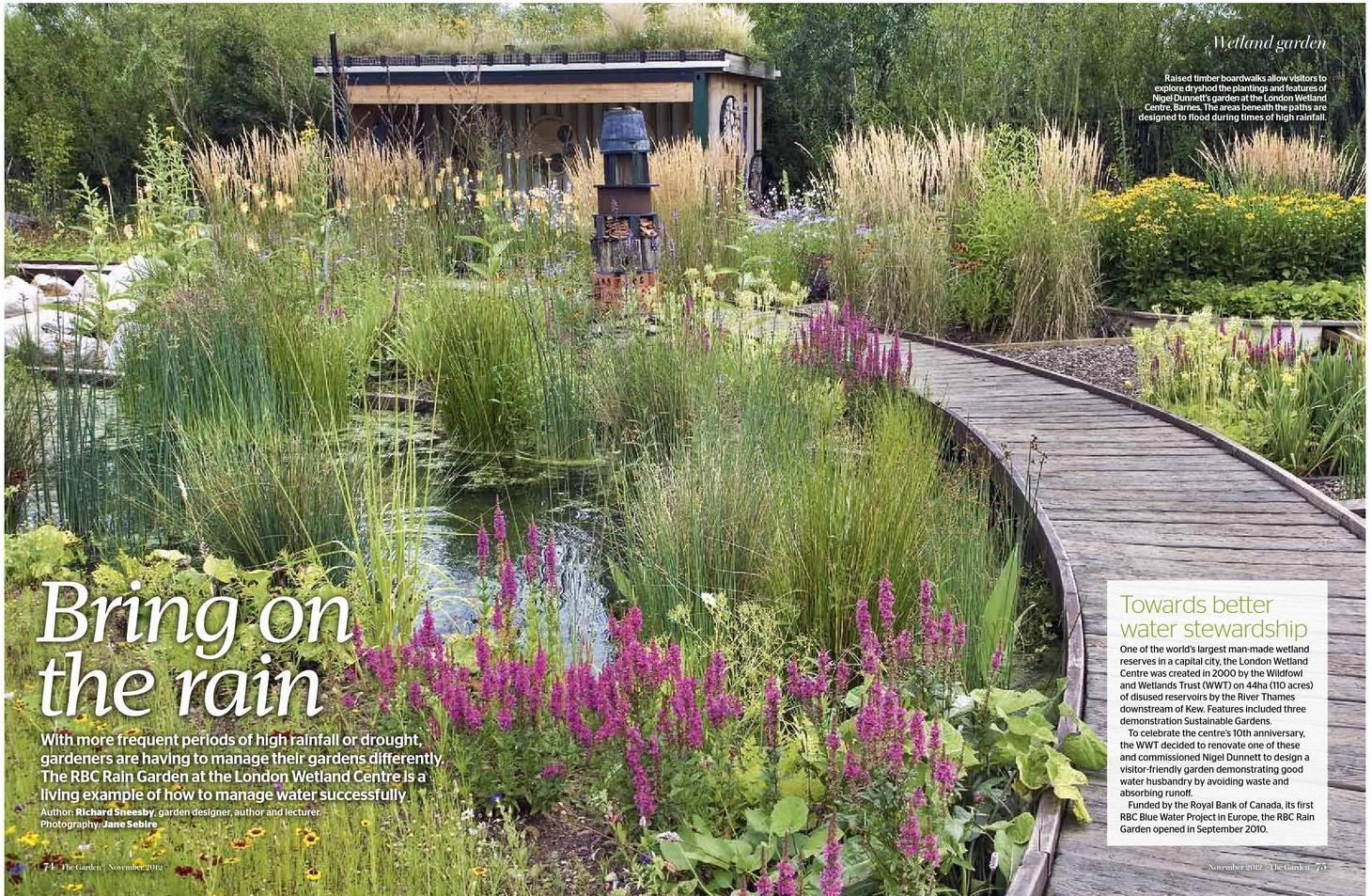
The RBC Rain Garden at the London Wetland Centre is a living example of how to manage water successfully. The designer, Nigel Dunnett of the University of Sheffield, approached the challenge using his extensive knowledge, making this garden one of the most interesting to be built in the UK for some years.
[issuu.com]


What makes Nigel's garden special?
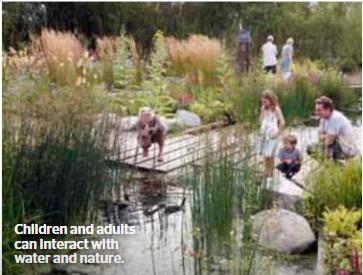
His circular design incorporates sweeping arcs of curved timber paths carved through tall flowering grasses and herbaceous perennials. These paths are raised above ground level to allow the underlying ground (but not people's feet) to get wet. A central axis is paved in permeable gravel with timber sleepers strategically placed across the main pond, allowing visitors to get up close
he has chosen those with physiological adaptations that allow them to survive and thrive in this stressful environment. They look good, too (this is a garden after all), making this a place for enjoyment, visual stimulation and somewhere to put us in a good mood
Nigel Dunnett's rain garden at the London Wetland Centre
His plant selection is thoughtful, creative and for all seasons. Many plants absorb excessive amounts of water and help control the moisture balance within the soil. The front of the garden is seeded with a Dunnett trademark, an annual pictorial meadow, similar to those at the London 2012 Olympic Park.
There are aquatic and marginal selections such as Schoenoplectus lacustris subsp. tabernaemontani Albescens, Persicaria bistorta Superba and Rodgersia pinnata Superba. These are supplemented with more ornamental subjects including Helianthus Capenoch Star, Astilbe chinensis var taquetti Purpurlanze and Rudbeckia fulgida var deamii




The Hepworth Wakefield Garden, designed by internationally acclaimed landscape architect Tom StuartSmith, is a beautifully landscaped garden free for all to enjoy.
Tom Stuart-Smith’s design draws inspiration from its unusual setting between 19th-century red-brick mills and a 21st-century art gallery, edged by the River Calder. It echos the striking, angular shapes of the David Chipperfielddesigned gallery while harnessing a naturalism that reflects Barbara Hepworth’s deep connection to the landscape



The University of Leeds has inspiring, memorable and unique built landscape. Their gardens and courtyards in campus show that the landscape development is to be an exemplar of urban biodiversity, creating a biodiverse environment and providing ecological corridors within the city. It was important for the campus landscape to be an inspiring place which encourages innovation, live research, learning and discovery. The external landscaping provides a relaxed, aesthetically pleasing setting, featuring breakout areas, a sustainable garden, and a biodiverse rain garden


The Nexus Building of University of Leeds with an impressive new entrance on Woodhouse Lane, Nexus forms a striking gateway between the city and the southern corner of the campus. A rain gardenhas been built as part of the development. This acts as a visually appealing, low maintenance and biodiverse friendly, sustainable drainage system.


 Bradford canal valley: water return
Bradford canal valley: water return
The soft landscape proposals largely focus upon the mass planting of wetland and wildlfower meadow habitats. This new area are highly important for the enhancement of the ecological framework. The establishment of wetlands and open wildflower meadows is sure to complement local ecology valua for the benefit of biodiversity and people alike.
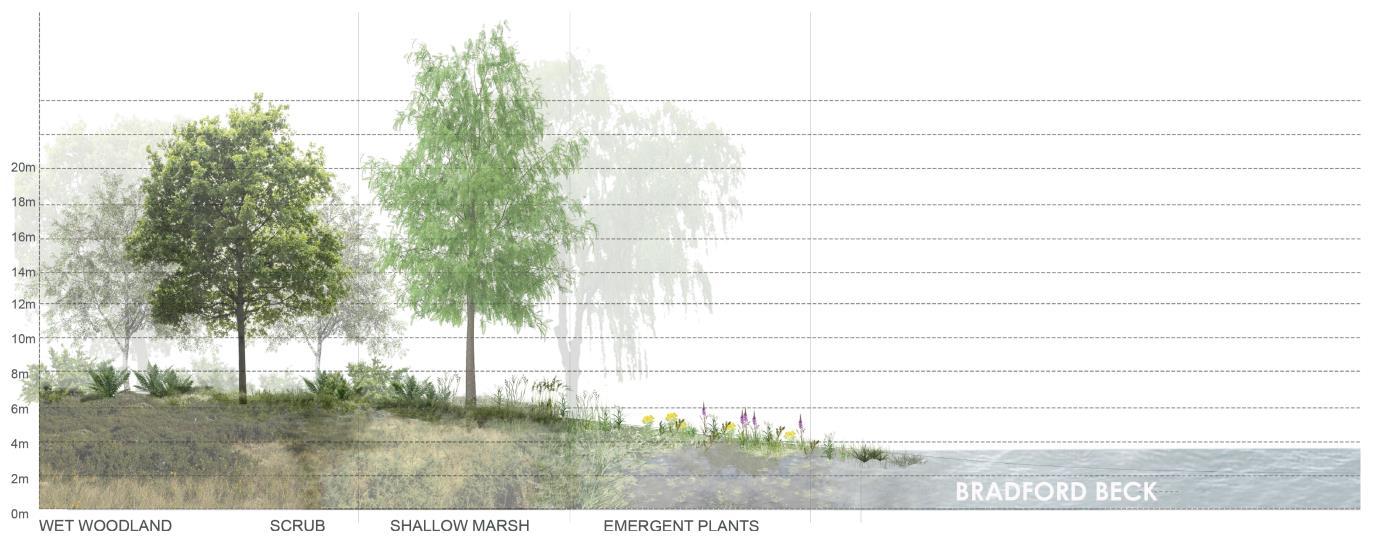
 Figure: Focus area for research planting in Major Design Project
Figure: wetland section
Figure: Focus area for research planting in Major Design Project
Figure: wetland section
The idea of planting in my Major design project concentrate in wetland area. My viewing deck beside the water and the wetland design incorpothe idearates sweeping timber paths carved through tall flowering grasses and herbaceous perennials. These paths are raised above ground level to allow the underlying ground (but not people's feet) to get wet, allowing visitors interact with water and nature
I choose those with physiological adaptations that allow them to survive and thrive in this wet and dry environment. They also look good, , making this a place for enjoyment, visual stimulation and somewhere to put us in a good mood
Plating schedule






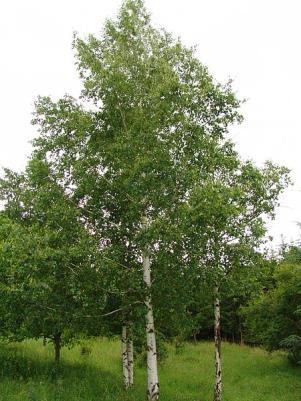

SECTION A-A’
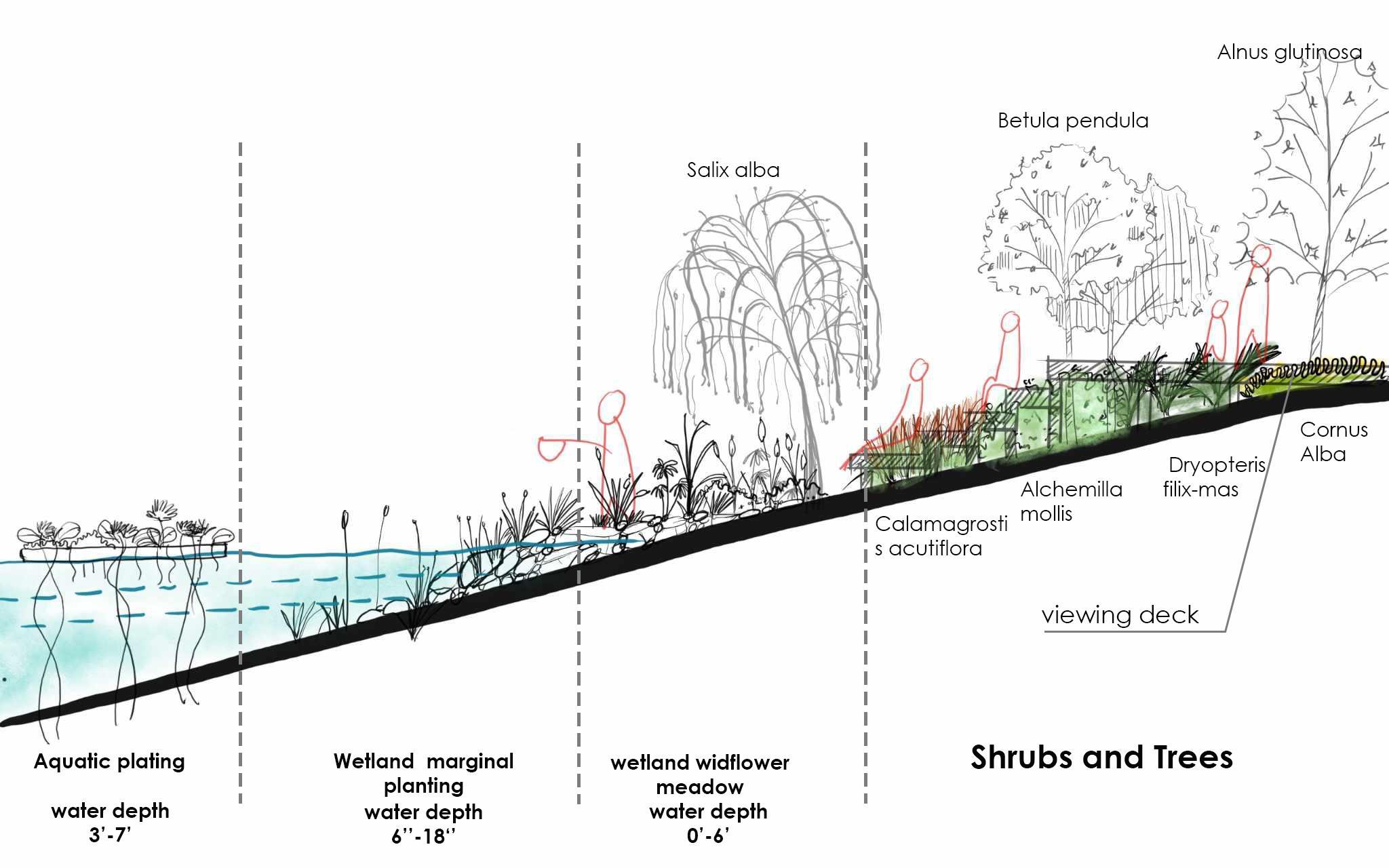 Cornus Alba
Salix alba Betula pendula Alnus glutinosa
Alchemilla mollis
Calamagrostis acutiflorat Dryopteris filix-mas
Cornus Alba
Salix alba Betula pendula Alnus glutinosa
Alchemilla mollis
Calamagrostis acutiflorat Dryopteris filix-mas

The proposed wildflower meadow mix credited to Landlife Wildflowers has been selected not only for the attraction of pollinating insects, but also for its suitability as a winter food source for wild birds. Consisting largely of perennials, the meadow will be a long-term attraction for wildlife and people. 75% of the wildfowers in the mix are recommended by the Royal Horticultural Society (RHS) as 'Perfect for Pollinators'.

The proposed wetland marginal mix contains a mix of native wildflowers and grasses for the benefit of local wildlife. Establishing a new wetland habitat, the proposed planting aims to both support and enhance the existing ecological framework of the area, increasing biodiversity by providing a range of habitats through the site. The marginal mix will help to build a habitat with the future in mind, comprising largely of perennial flowers and grasses. The resilience of the overall scheme is therefore supported, with long-term goals in mind for the wetland which will support both local people and wildlife for the foreseeable future.
Web References:
Nigel Dunnett, www.nigeldunnett.com [online] [accessed on 01.09.2023]
www.ukgardening.co.uk. (n.d.). Planting seasons in the basics of gardening, from UK Gardening. [online] [accessed on 01.09.2023]
Rhs.org.uk. (2019). Help, advice & tips from the RHS on all kinds of plants / RHS Gardening. [online] [accessed on 01.09.2023]
identify.plantnet.org. (n.d.). Identify, explore and share your observations of wild plants. [online] [accessed on 01.09.2023]
www.ukgardening.co.uk. (n.d.). Planting seasons in the basics of gardening, from UK Gardening. [online]
issuu.com. (2012). London Wetland Centre Rain Garden feature by Nigel DunnettIssuu. [online]
Books References:
Piet Oudolf and Noël Kingsbury (2009). Designing with plants. London: Conran Octopus.
Nigel Dunnett, N. (2019). Naturalistic planting design : the essential guide. Great Britain: Filbert Press.
